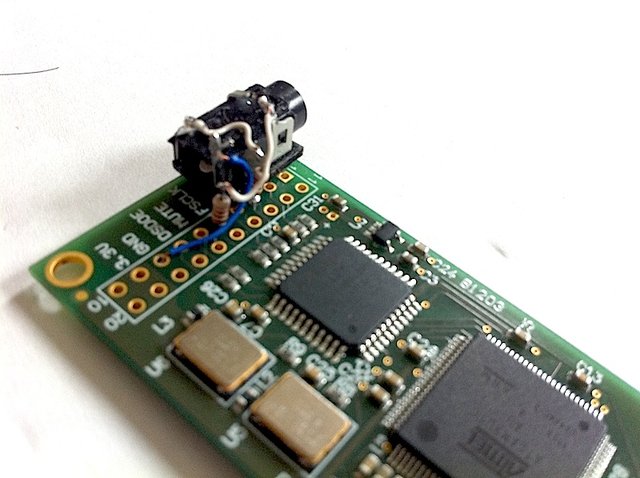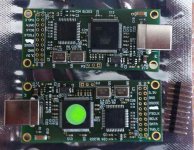Hi Bunpei,
- thanks for posting and giving this link but I don't understand what it says
Google translate gives me a hint about it but not to an extent that it is becomes "usable" ...
But in another thread - I think it was on the SDtrans384 - I noticed that you mentioned a LPF filter (LCR) you made for this device. I reckon it's basically enough to know the output impedance of the sending end (the I2S output impedance) and the receiving end and then calculate the values of L, C or R needed, right?
Will get back to you later on email
Jesper
- thanks for posting and giving this link but I don't understand what it says

Google translate gives me a hint about it but not to an extent that it is becomes "usable" ...
But in another thread - I think it was on the SDtrans384 - I noticed that you mentioned a LPF filter (LCR) you made for this device. I reckon it's basically enough to know the output impedance of the sending end (the I2S output impedance) and the receiving end and then calculate the values of L, C or R needed, right?
Will get back to you later on email
Jesper
Bunpei,A Japanese user made a very simple
discrete direct DSD/analog converter (in Japanese) with using one chip device.

Do you know what is the device in the picture?
Looks pretty identical to the amanero board.................
Cheers,
Nic
Bunpei,
Do you know what is the device in the picture?
Looks pretty identical to the amanero board.................
Cheers,
Nic
Hi ... Bunpei probably knows for sure ... but amanero pops up from time to time in the google translated text on link he gave ...
Regards,
Jesper
Hi, gentlevoice and NicMac,
I should have clarified that "the board was amanero and he connected his own discrete direct DSD/analog converter to the DSD output terminals on the board".
To gentlevoice
Your guess was correct. His converter is a single resister of 1k ohm as a LPF.
I believe it is far more simple, less expensive, feasible and reproducible than the complicated one appeared in a dRaydream.
To NicMac
His conclusion was that "the aggregation of all" matched his taste the best.
I should have clarified that "the board was amanero and he connected his own discrete direct DSD/analog converter to the DSD output terminals on the board".
To gentlevoice
Your guess was correct. His converter is a single resister of 1k ohm as a LPF.
I believe it is far more simple, less expensive, feasible and reproducible than the complicated one appeared in a dRaydream.
To NicMac
His conclusion was that "the aggregation of all" matched his taste the best.
I believe it is far more simple, less expensive, feasible and reproducible than the complicated one appeared in a dRaydream.
Last edited:
Don't even care to read about ityou might sleep for a hundred years when you have read about all the dRayDream´s

Usual esoteric overshoot stuff aimed at ripping people of without any measurable/audible benefit. Wired with gold wire I assume.......
I much prefer a single 1k resistor solution.
i'm not discouraged, part of the reason I got this thing was to experiment with direct out, maybe not just a single resistor though...... with the USB board being usb powered this would mean USB ground passed right through… thats what you call terrible PSRR 
hey maybe a high bandwidth transformer could be used as filter and isolate the output ground.
but a few extra parts and perhaps battery psu it could be winning
think i'll skip the blurb too...

hey maybe a high bandwidth transformer could be used as filter and isolate the output ground.

but a few extra parts and perhaps battery psu it could be winning
think i'll skip the blurb too...
Last edited:
Ok. Back on topic
Found something in my incoming post today........
NicMac, Do you know why "MUTE" in your boards is been painted over?
No. Maybe Domenico can enlighten us....NicMac, Do you know why "MUTE" in your boards is been painted over?
Mute signal has been reassigned to Pin 11 and Pin 6 now is MCLK (master clock )
http://www.amanero.com/drivers/combo384-D.pdf
http://www.amanero.com/drivers/combo384-D.pdf
@kevinkr:
Bruno Putzeys of Hypex amplifiers has suggested a fast CMOS flip-flop as a DAC for one-bit signals ...
@rayCtech: Thanks for outlining your approach to designing a discrete DAC in one of the previous posts. The theory behind this is beyond my understanding, however, I wonder how it's possible - to a large extent - to genuinely "expand" on the original information available in e.g. a 2.8 MHz one bit signal? I reckon that even if some aspects of the original signal can be changed/altered/improved there's still "only" 2.8 MHz 1 bits available ...?
Greetings,
Jesper
Just added myself to the list for two.. Building a new dac or two in the near future.
Bruno Putzeys of Hypex amplifiers has suggested a fast CMOS flip-flop as a DAC for one-bit signals ...
@rayCtech: Thanks for outlining your approach to designing a discrete DAC in one of the previous posts. The theory behind this is beyond my understanding, however, I wonder how it's possible - to a large extent - to genuinely "expand" on the original information available in e.g. a 2.8 MHz one bit signal? I reckon that even if some aspects of the original signal can be changed/altered/improved there's still "only" 2.8 MHz 1 bits available ...?
Greetings,
Jesper
Bruno Putzeys of Hypex amplifiers has suggested a fast CMOS flip-flop as a DAC for one-bit signals ...
A much better approach would be a ECL flip-flop with TTL in and balanced ECL out...
The rail to rail and class B / D type of clipping and "sticking" to ground and the PSU rail and high frequency generation will be exchanged with class A performance and controlled voltage swing.
I wonder how it's possible - to a large extent - to genuinely "expand" on the original information available in e.g. a 2.8 MHz one bit signal? I reckon that even if some aspects of the original signal can be changed/altered/improved there's still "only" 2.8 MHz 1 bits available ...?
I have a website under construction and there will be more informations in the technology section and in the white papers there.
doesnt really sound like the DSD direct filter is ..you you say....'optimal'?
then again it was hard going even with chrome translator, it did seem to be a theme among thos he tried with the LPF compared to using ESS DSD mode
As far as I know, more than ten people in Japan tried their own "easy LPF" methods to play DSD raw signals without DAC because two DSD64,128,256 compatible transports, Chiaki's SDTrans and ElectrArt's USB Dual Audio are popular among them. Some try a single LCR, other try line tranformers & load resistors other than a single R. No one say "It is optimal" as they suffer residual digital noises that is hard to be eliminated completely. However, most of they say "more vivid or fresh with enough resolution than expected".
The author of the blog page says, Amanero Combo384 is a suitable platform of high cost performance and good availability to experiment such a DSD "playing". His usual DAC is not ESS-based one but FN-1242A(by Japanese manufacturer)-based one.
..... with the USB board being usb powered this would mean USB ground passed right through… thats what you call terrible PSRR ...
The reason why the author of the blog page tried a various bypass capacitors was that the behavior of residual noises was variable depending on USB cabling methods. I think his finding may mean your worries.
Any of you know of a DAC that converts 44.1 - 384 kHz/24 bits and also 128fs direct DSD (i.e. without multibit conversion etc.)?
Do you mean, even for DA conversion of PCM you want not multi-bit but 1-bit delta-sigma modulator?
If so, I'm afraid no modern commercial DAC chips satisfy your requirement.
If you allow a multi-bit delta-sigma modulation for PCM, TI BB DSD1794A(and its family models) may meet your conditions because only analog filter is applied to DSD input signals under their "Advanced Segments" architecture. DSD1794A supports DSD64, DSD128 & DSD256.
- Home
- Vendor's Bazaar
- USB to I2S 384Khz - DSD Converter

